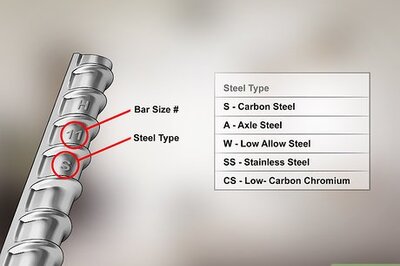
views
The COVID-19 pandemic has significantly shifted the real estate industry towards digitisation, spurring the emergence of India’s property technology market. Video walkthroughs of properties have become especially popular, drawing in a plethora of home-seekers. Riding on this wave of digital transformation, experts anticipate that proptech will reach its peak in terms of market value – with a projected $1 trillion — by 2030 and contribute 13 per cent to India’s gross domestic product by 2025. Step aside from traditional home-searching, the future of real estate buying is here!
As the rising costs of housing are the major challenge faced by people in India, it has made it almost impossible for people to buy it at affordable prices. This challenge is further worsened by the lack of capital for real estate developers and limited government initiatives for affordable housing.
To tackle the problem of affordable housing, Proptech – a term used to describe the integration of technology with real estate, is slowly becoming popular in India. Proptech can simplify the home-buying process in several ways. For starters, it allows people to find more information quickly and easily. By utilising information technology platforms and other resources, people can now find out detailed information about home prices and other related resources.
Furthermore, PropTech services can make the housing search process simpler and quicker. Instead of having to manually visit several properties, people can now find the homes they’re looking for from the comfort of their homes.
Tech Innovation Redefining Real Estate
From virtual tours to online bookings, it is evident that proptech will play a vital role in creating efficiencies within the affordable housing ecosystem and disrupt all processes in the development cycle. Undoubtedly, proptech in India has evolved dramatically after the pandemic. Today, new technologies such as artificial intelligence, augmented reality, and big data analytics are enabling an immersive viewing experience, especially when the buyer or property is at an overseas location.
Burgeoning Middle Class Driving Housing Demand
In India, housing is primarily characterized by a growing demand for homes among first-time buyers. Since the income levels of the younger generation are rising quickly, they are able to afford homes sooner in life. In fact, as per the Reserve Bank of India’s residential asset price monitoring survey across 13 cities, Indians now spend a bigger chunk of what they earn on buying a home than in 2015. But cost optimisation is critical for an affordable housing project to be financially viable.
Property prices are usually very high, and construction costs contribute massively to increasing overall housing prices. To tackle this, the construction sector also must stay ahead of the curve by keeping a check on price hikes in building materials like steel and cement, as those costs could get passed on to homebuyers.
According to KPMG’s reports, 900 million people will be added to Indian cities by 2050. This will spur the requirement for high-end, mid-income, and affordable housing. Plus, with the government’s increased focus on building smart cities; special economic zones, and townships through Pradhan Mantri Awas Yojana, the demand for better infrastructure and residential housing is poised to accelerate in the future.
A Gamechanger for Affordable Housing
Proptech solutions can bring drastic improvement in housing affordability during the planning and construction stage. Proptech and construction technology are at an exciting juncture and are already becoming disruptive forces driving cost reduction for residents and owners.
In recent times, Building Information Modeling (BIM) has been making strides in the construction industry. According to a report by Markets and Markets, the Asia-Pacific region (APAC) is poised to witness the highest CAGR (16.6 percent) in the Building Information Modeling market during the 2020-25 period. For labor payrolls, prefabricated or modular pieces, BIM technology can provide cost estimation in advance. A suite of solutions promises to bring efficiency at every stage of property-related transactions:
3D-Printed Homes
The basic concept of 3D printing involves finding the right material to print with. This helps eliminate a significant amount of material waste, cuts labor requirements, and leads to cost savings. Since 3D-printed homes cost 50 to 80 percent less than traditionally-built homes, they could easily propel the affordable housing market to the next level.
See how Chennai-based 3D printing startup Tvasta Manufacturing Solutions has built India’s first-ever 3D printed house. They have developed a ‘Made in India’ technology that focuses on automation and robotics in 3D printing platforms to provide low-cost construction solutions. If adopted at a large scale, this approach could effectively address the housing needs of millions of Indians.
Pre-Fabricated Buildings
The supply of sustainable affordable housing is a huge challenge in a developing nation like India. Prefabricated construction technology (PCT) has the potential to address the huge urban housing shortage and provide significant economic and environment-friendly benefits.
An international design and innovation practice based in Turin and New York, Carlo Ratti Association has worked with the Indian non-profit organization WeRise to develop Livingboard, a flexible prefab housing system to improve housing conditions in rural parts of India. They have made a prototype of a portable motherboard made of low-cost materials that allow people to build their own dwellings on top of a prefabricated core. The widespread adoption of prefabricated construction has tremendous potential to revolutionise Indian real estate and meet the ever-growing demand for affordable housing.
What’s In Store for India’s Proptech Market
HDFC Capital and Invest India launched ‘HDFC Real Estate Tech Innovators 2022’ in September 2022, aiming to reward disruptive innovations in the Construction Tech, sales tech, FinTech, and Sustainability Tech verticals. HDFC’s H@ART platform is committed to investing in 15 prop-tech startups that focus on improving affordability in the housing sector.
Propping up investments in prop-tech, the Real Estate 3.0 report suggests it will reach $1 billion in 2025, twice what was invested in 2020. India’s Government campaigns like Digital India and Smart cities’ mission is encouraging the use of proptech to improve affordability and shape the future of real estate.
(The author is founder and chief operating officer of BASIC Home Loan)
Read all the Latest Business News here




















Comments
0 comment